|


The Experiences
Experience The Experience Of Being
Buried Alive (June 14/8 PM: Los
Angeles, June 30/8 PM: Vancouver, July 8/7 PM: San Francisco)
Experience
The Experience Of An Illegal Space Race
(June 25/ 2 PM: Los Angeles)
Experience
The Experience Of Growing Money
(July 14/ 8 PM: San Francisco)
Experience
The Experience Of A Magnetism Party
(June 18/8 PM, Los Angeles)
Experience The Experience Of Catapulting Wireless
Devices (Workshop: July 9/6 PM; Event: July 16/2 PM, San Francisco)
Experience The Experience Of A Brick Of Coke
(June 21/8 PM: Los Angeles)
Experience The Experience Of 1 Baud
(Workshop: July 20/6 PM; Event: July 22/5 PM: San Francisco) |
|
|
Experience The Experience Of Being Buried Alive
|
The people present will have an opportunity to be buried alive in a coffin for fifteen minutes. As a framework program there will be lectures about the history of the science of determining death and the medical cultural history of "buried alive". People buried alive not only populate the horror stories of past centuries, but also countless reports in specialized medical literature. The theme of unintentional resurrection by grave robbers also runs through forensic protocols. Even in the 19th century it was said that every tenth person was buried alive. No wonder that the fear of this fate was immense and led - especially in the German-speaking region - to all kinds of precautions to avoid it. Various death test methods were developed, for instance. "Security coffins" with bell pulls and air hoses were patented; mortuaries were built, in which corpses were left for days to natural decay.
Los Angeles (Machine Project): June 14, 8 PM.
Vancouver (Contemporary Art Gallery): June 30, 8 PM and July 2, 4 PM.
San Francisco (RxGallery): July 8, 7 PM.
|
Press
July 14, afternoon.
We get some brand new articles mailed.
National Post, Canada, July 14
(click to enlarge)
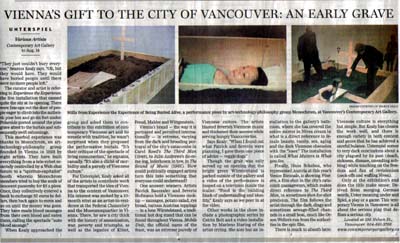
The Georgia Straight, Vancouver, July 14:
(click to enlarge)
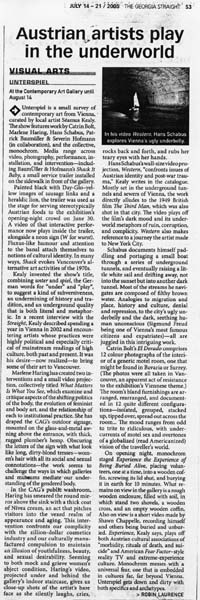
And after much delay, the Los Angeles radio show appears to be airing July 16th.
July 16: Someday your computer might use smell, touch and taste. Weekend America host Bill Radke explores the world of sensual computing. And, why are people getting buried alive... voluntarily?
Source: weekendamerica.publicradio.org
[posted by johannes at
2:59 PM]
Clearance
July 9. Evening.
Günther is terrified. He discovers a couple of black body bags on our graveyard.
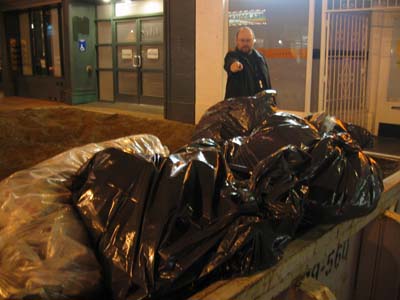
The bags only contain a couple of dead chickens. We breathe a sigh of relief.
July 9. Morning and afternoon.
The dumpster company refuses to collect the debris box because it's full of stinking waste.
Cleaning. Necessary. Yuck.
Finishing basic job.
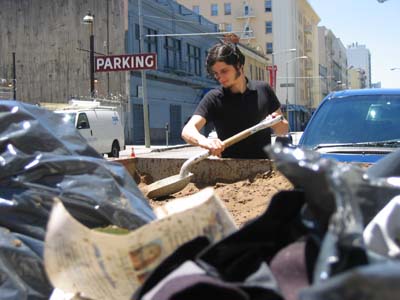
Calling street cleaners.
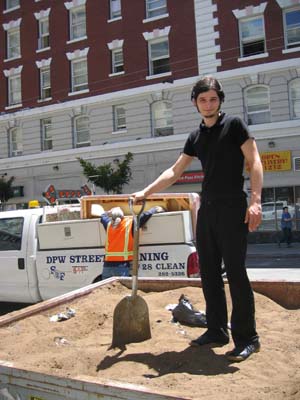
Undigging.
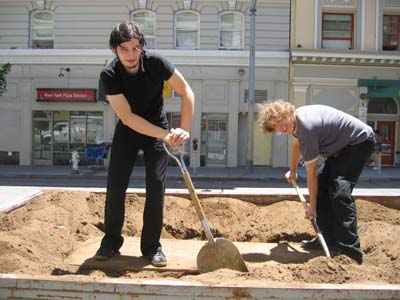
More undigging.
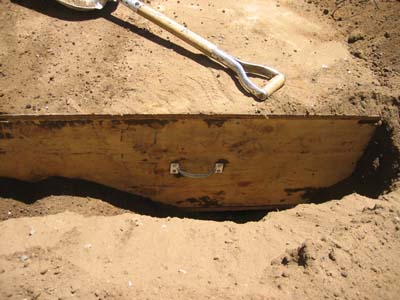
Exhuming coffin.
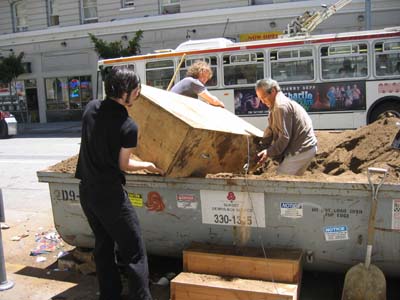
Carrying coffin.
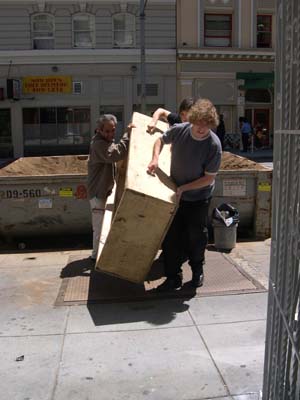
Storing coffin.
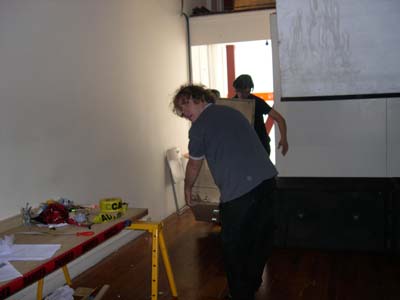
Done.
Because Günther is sick a guy wearing bedroom slippers helps us.
We pay him a couple of bucks. He happily invests the money in a Burrito Supreme and a bottle of bottom shelf liquor.
July 13. Morning.
Dumpster is gone.
Bye bye, dumpster.
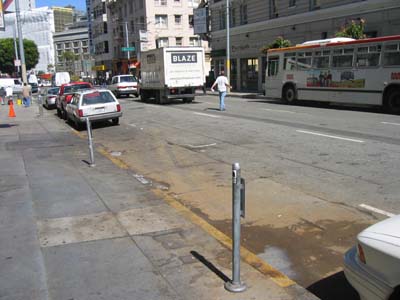
[posted by johannes at
4:39 PM]
San Francisco Auto-Funeral Experience
July 8. Evening.
6:30 PM:
People are already waiting in front of the gallery to get in line for the burial.
7:30 PM:
The crowd is waiting patiently.
We begin with the intro talk.
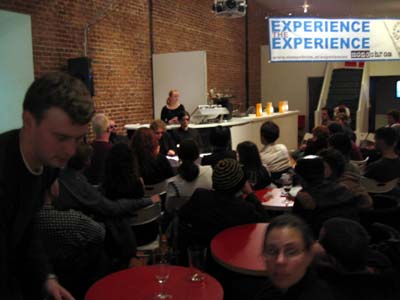
The fear of being buried alive is one of our most primal fears. The mere thought gives us the creeps and makes our hearts beat faster. We find reports about people awaking on their alleged deathbed even in classical antiquity.
Our speech deals with the cultural and scientific history of premature burial.
Anika's job is Death Jockey, behind the turntables...
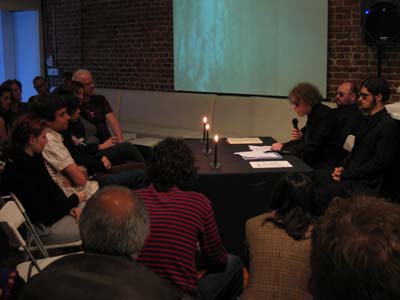
...but she's in fact the head of the Department of Burial Administration.
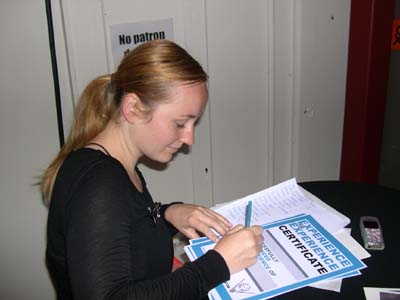
The waiting queue nearly stretches down the block and it takes Anika about half an hour to administer the bureaucratic paperwork.
It's rather cold and foggy. Perfect funereal weather. Welcome to San Francisco.
First we bury Sam. May he rest in peace... for ten minutes.
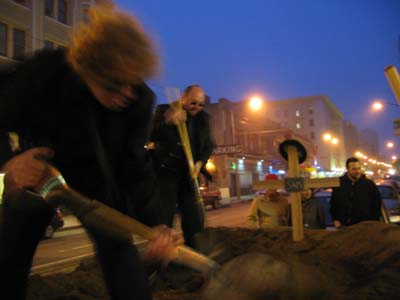
His friends and family mourn his death... to the max.
Countdown to resurrection.
Praise the Lord!
Sam is alive!
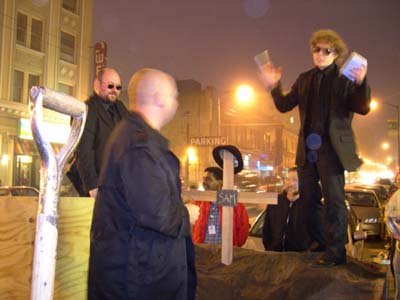
Johannes and Günther burn (dead) calories.
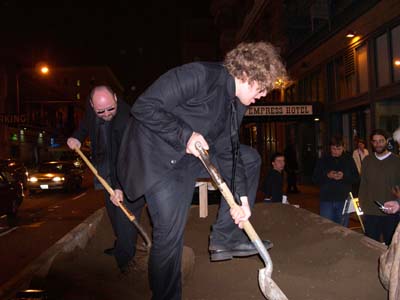
Free.
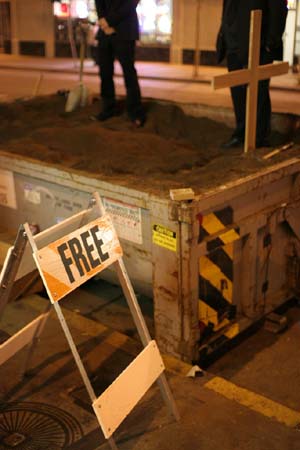
Burial.
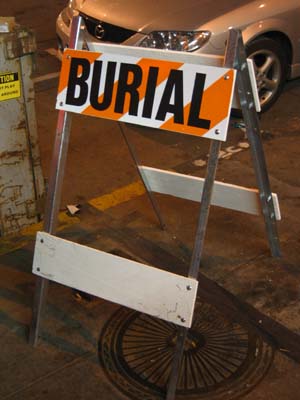
Many volunteers decide to decorate the cross with personal belongings... even if they consider themselves to be brute force atheists.
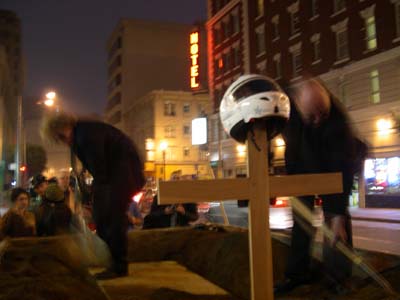
Our job? To entertain the public with tales about resuscitation and necrophilia, and with obviously sadistic overtones. And to dig.
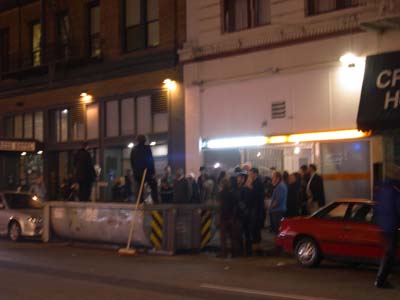
Police forces are government organisations charged with the responsibility of maintaining law and order. The word comes from the French, and less directly from the Greek politeia, referring to government or administration.
Several police cars go by and observe our ceremony. One car stops next to our graveyard on Eddy Street and stays there for 7 minutes. The officers want to witness the next exhumation. They are our friends, but they don't help us.
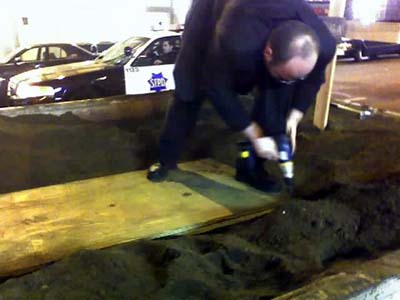
Burials may be placed in a number of different positions. Christian burials are made extended, i.e., lying flat with arms and legs straight, or with the arms folded upon the chest, and with the eyes and mouth closed.
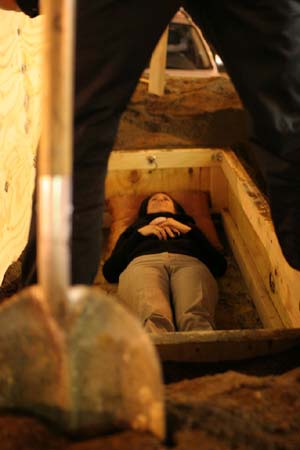
Smile.
Get out of the coffin.
Good bye.
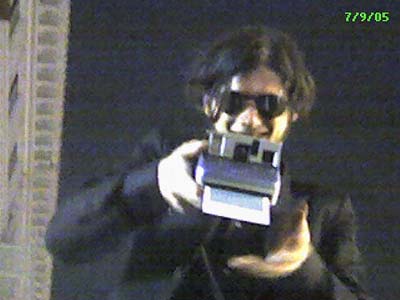
A couple of sinister spectators try to pilfer our equipment.
And even our christian symbol. An intoxicated, anonymous man has the cunning plan to take it home...
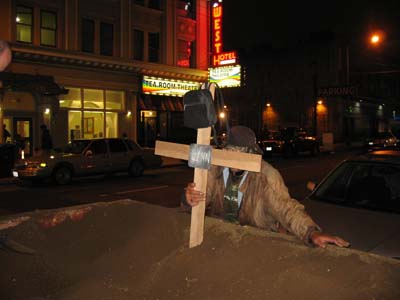
...but Nike and Mike, our watchful security team, prevent any kind of grave defilement.
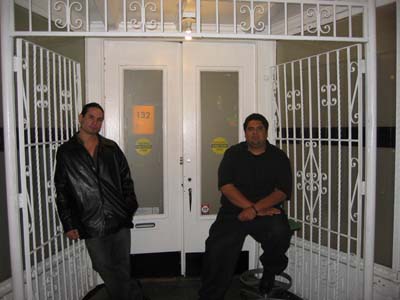
Burial, also called interment and (when applied to human burial) inhumation, is the act of placing a person or object into the ground. Usually, this is accomplished by digging a pit or trench, placing the person or object in it, and refilling it with the soil that was dug out of it.
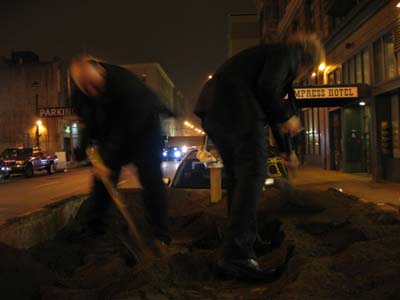
Quality is our recipe.
But one volunteer chickens out and aborts the burial after 5 seconds.
We refrain from posting his picture.
But this guy here is really enjoying his stay. He even takes off his shoes.
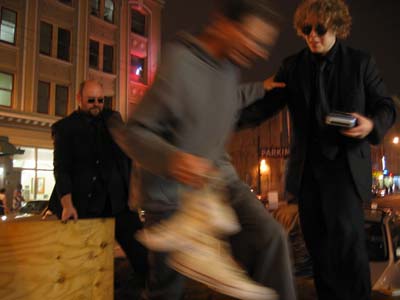
Citizen Praveen is the next in line.
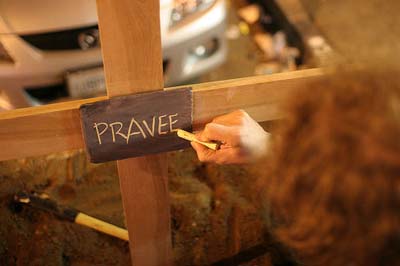
Citizen Praveen via coffin cam.
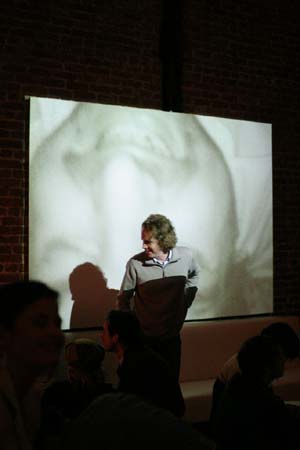
Citizen Praveen is very, very proud.
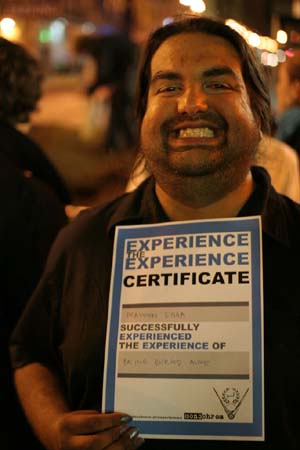
Team leader Anika is very, very proud.
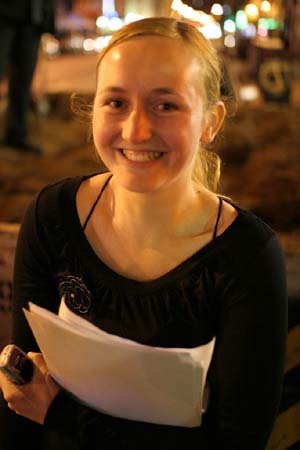
Alert! Major lid malfunction.
The screws break! We have to decamp the coffin.
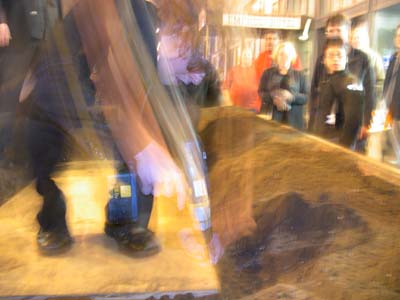
Wal-Mart Stores, Inc., founded by Sam Walton in 1962, is the largest retailer and largest company in the world based on revenue.
None the less they sell hideous screws and have hideous labour policies.
Die.
Die.
Die.
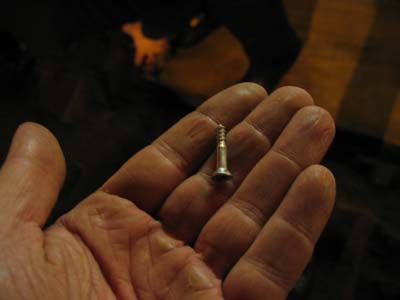
Anika is complaining about the delay due to screw screw up.
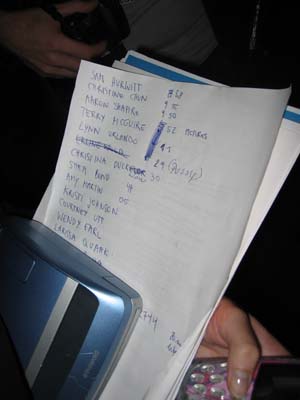
Johannes has to cancel his work break.
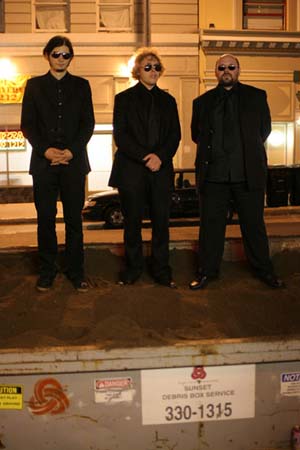
"Means for work, man... means for work."
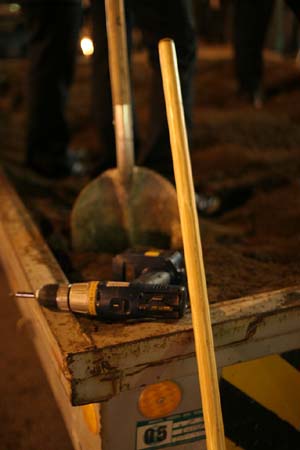
Amy, inside the coffin.
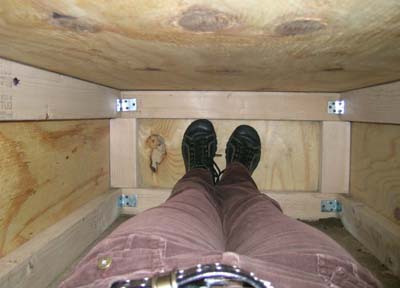
Amy, still inside the coffin.
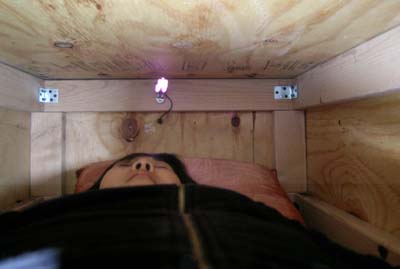
Our condolences.
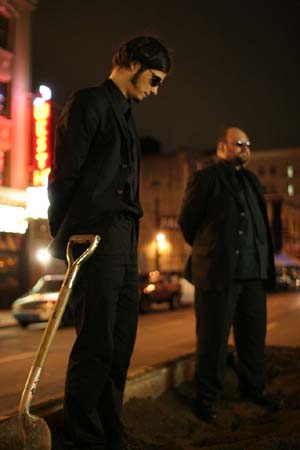
Our pleasure.
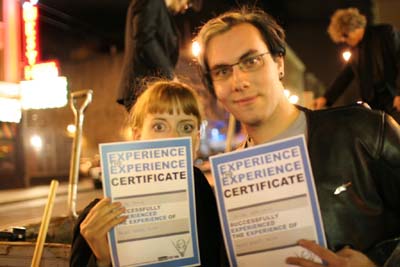
Our guests.
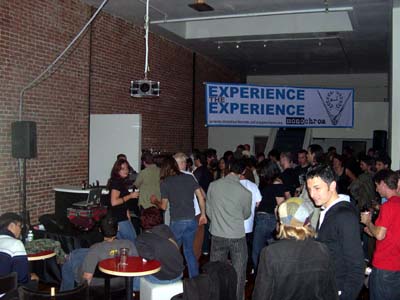
Our business.
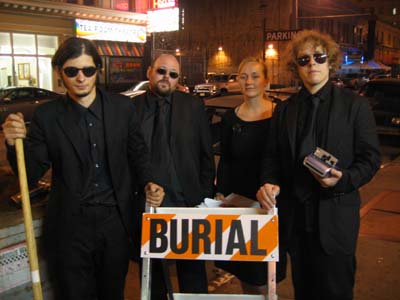
All 14 (+1) volunteers on a picture...
(Click to enlarge.)
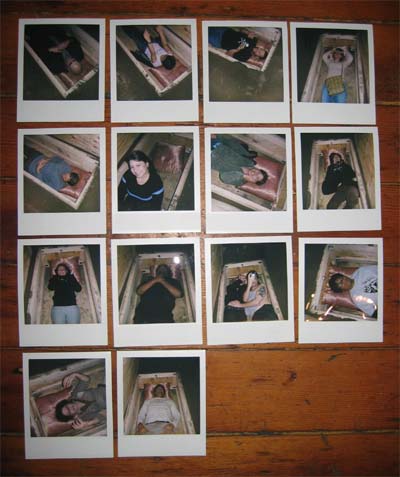
Thanx to
Jake Appelbaum (http://flickr.com/photos/ioerror/tags/monochrom/)
Reasoner (http://reasoner.experiencethis.org/archives/124)
Karen Marcelo (http://karenmarcelo.org)
Mecredis (http://www.flickr.com/photos/fcb/24620392/)
and Amy Martin
for taking incredible pictures.
[posted by johannes at
6:31 AM]
Final adjustments
July 8. Afternoon.
Daniel and Anika arrive at the gallery.
Here's a picture with Monika.
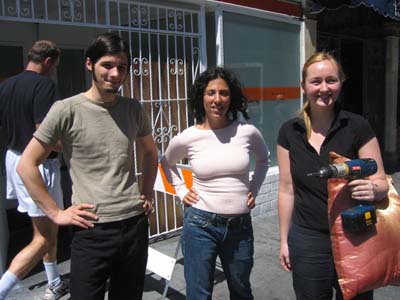
Oh no! Problems with the power supply of the coffin cam.
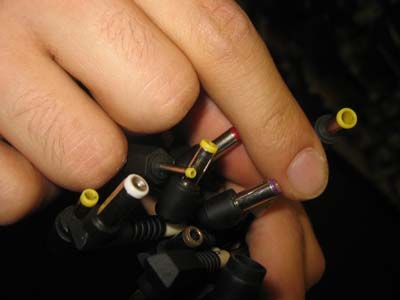
Radio Shack shall cast them down to hell, and deliver them into chains of darkness, to be reserved unto judgement! Praise Radio Shack!

Daniel finishes the job. But he still lacks proper sunglasses and a black tie.
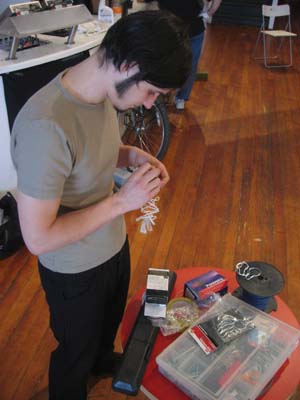
Adhesive letters galore.
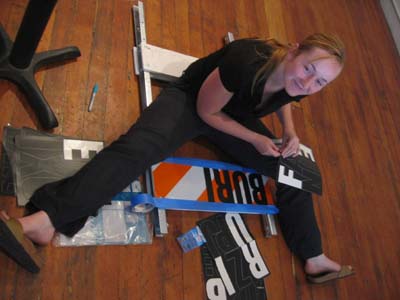
Günther and Daniel lay the video cable.
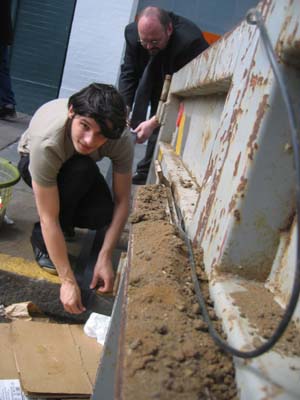
We notice fundamental disrespect for our graveyard. Daniel has to remove old clothes, rum bottles and poultry parts.
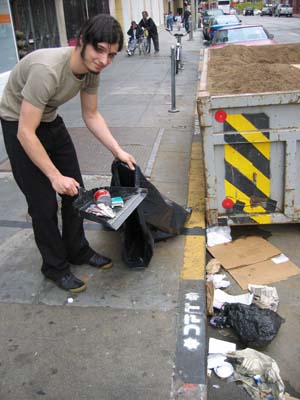
Will adjusts the gravesite cam.
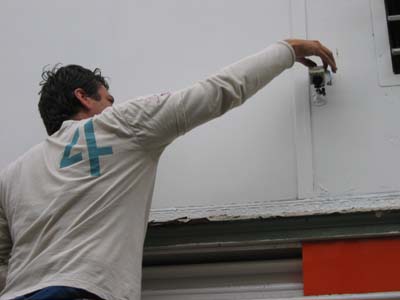
Clear signal.
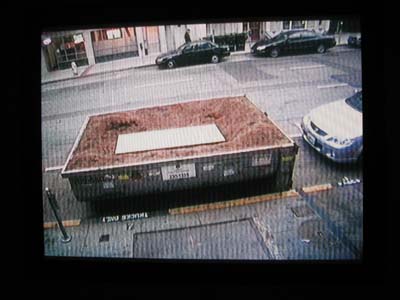
Daniel buys proper sunglasses at a drugstore.
The team is ready -- finally.
It's time.
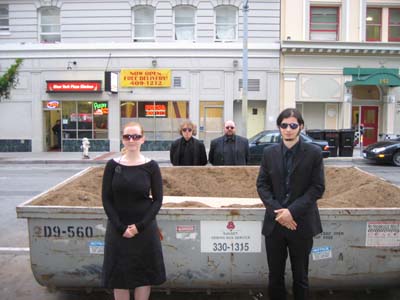
[posted by johannes at
7:00 PM]
Dumpster Preparations
July 8. Morning.
Daniel and Anika are still asleep.
Johannes, Günther and Will block the parking space in front of the gallery.
Conversation with man passing by:
- "Why are you taking a picture of a traffic cone?"
- "Just documentation. We build a gravesite."
- "Yeah, cool, man."
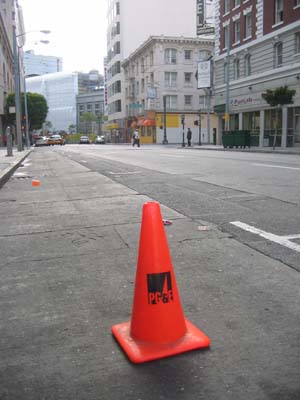
Dumpster arrives.
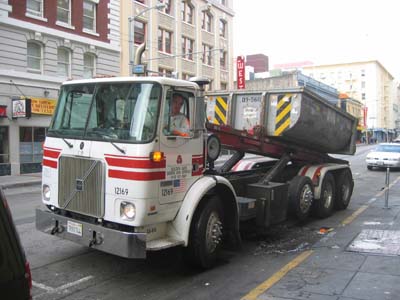
3/4 full, as ordered...
10 US tons of payload.

Superior quality dirt with decorative pebbles.
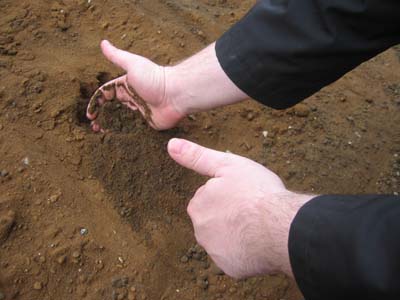
We pay 145 units of local currency, including tax.
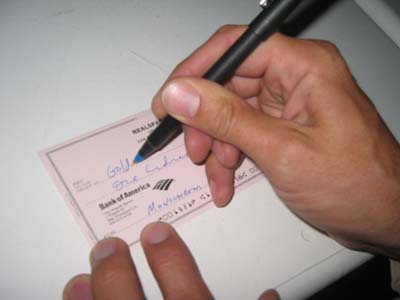
(Click to enlarge.)
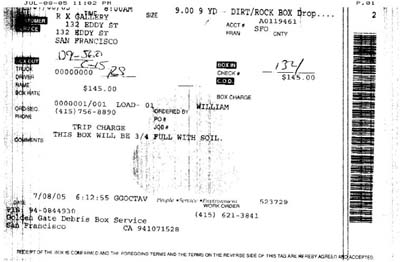
Processing hole.
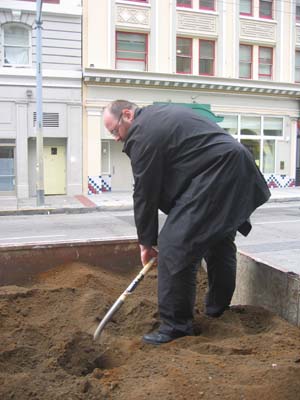
Conversation with woman passing by:
- "What are you guys doing?"
- "Digging a hole."
- "Crazy motherfuckers! Where are you from?"
- "Austria."
- "Holy shit."
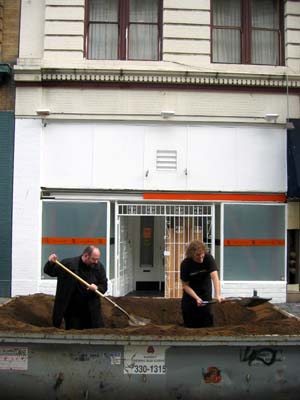
Conversation with man passing by:
- "Hey man, what are you doing? Wanna bury someone alive?"
- "Yes, basically."
- "No kidding?"
- "No kidding. Today at 8. Wanna try?"
- "Jesus help me, no!"
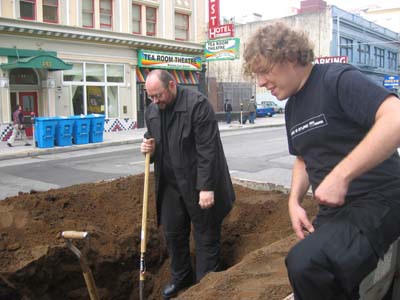
Problem: Big dumpster still too small. Where to put the dirt?
Solution: None.
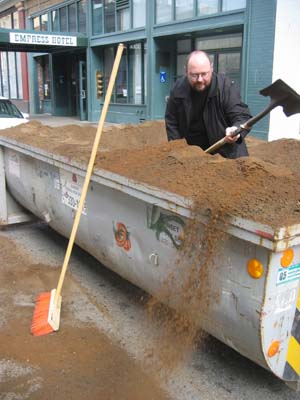
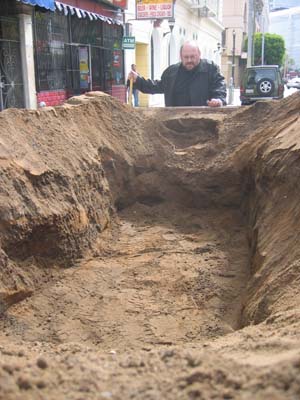
Please insert coffin.
Press any key to continue.
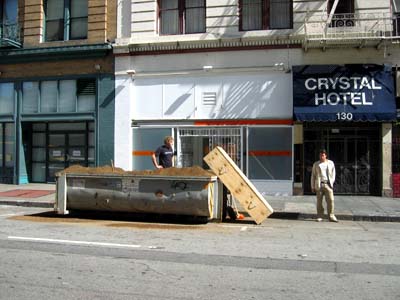
Conversation with man passing by:
- "Who's in there? Jimmy Hoffa?"
- "No, but you could. Here's my business card. Call me."
- "Thanks."
- "You're welcome."
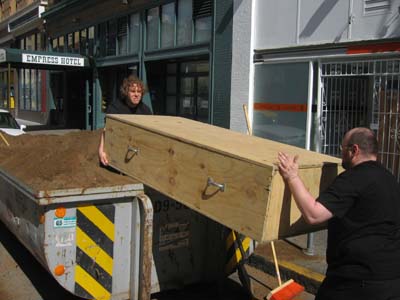
We realize that the ground is not level.
As we don't want our volunteers to experience the experience of a head-down-tilt coffin rest, we try to fix the problem.
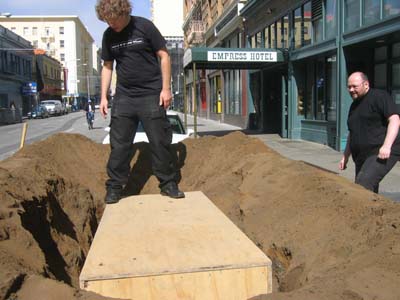
Coffin is still a little bit out of level. But our guests will enjoy the comfort of a big pillow, anyways.
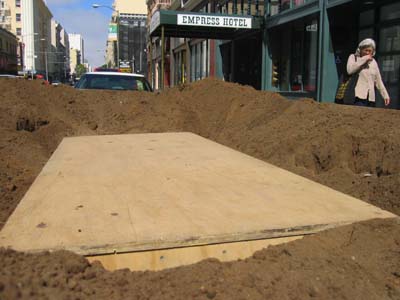
And, by the way, we'll do an interview with 97.3FM in Brisbane/Australia on sunday.
[posted by johannes at
11:04 AM]
Schedule still tight
July 7. Morning.
9:30 AM:
The early bird catches the media.
Johannes is giving an interview for Wireless Flash News. He talks about medieval burial rituals, standard Canadian coffin sizes and 19th century mass hysteria in Germany. Günther takes a snapshot of him randomly strolling around the rental appartment. Johannes looks deranged and casually sways a creepy puppet, part of the interior design of the flat.
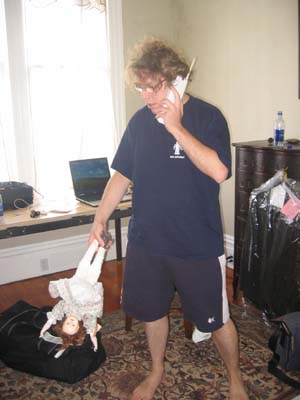
11:30 AM:
Johannes and Günther meet with Monika and Will at the gallery.
Johannes prepares the premature burial damage waiver.
(Download RTF version here.)
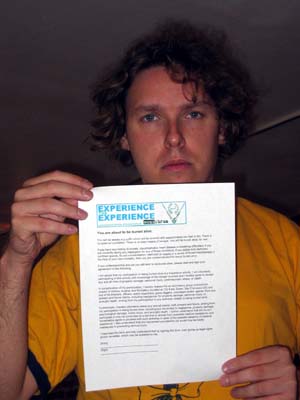
In the meantime Will finishes his phone quest for a cheap debris box.
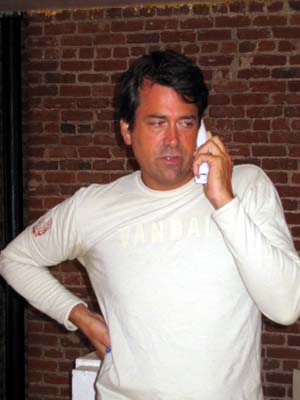
Triumph!
Dumpster rented.
Delivery: July 8, 8 PM.
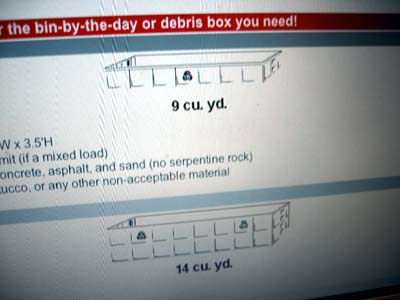
Early afternoon.
We learn to know that Geoff White (Ghostly, Force-Inc., Traum) will play a resurrection gig after the burial ceremony. Excellent!
Lots of computer work to do.
People keep sending emails. We should write a FAQ.
Vinc arrives and puts up the banner.
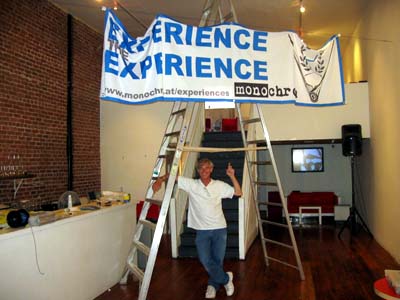
4 PM:
Johannes discovers a nice wooden board in the basement.
Vinc takes it home to build a cross.
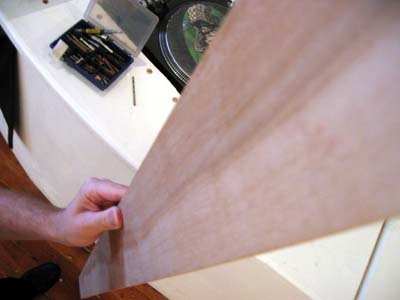
5 PM:
Vinc returns. We can't believe it!
Christian symbolism is the use of actions or objects to represent the truths of the Christian faith, either as a reminder of those truths or as a way of spiritually connecting with the underlying truth or act. And this one is really beautiful, in addition.
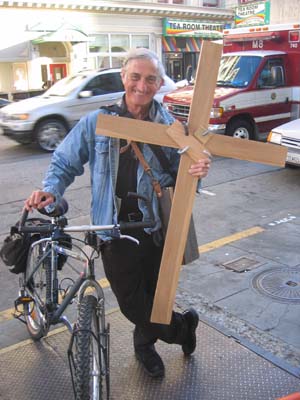
We transport the coffin on a cart from the storage room to the gallery.
We cross Market Street.
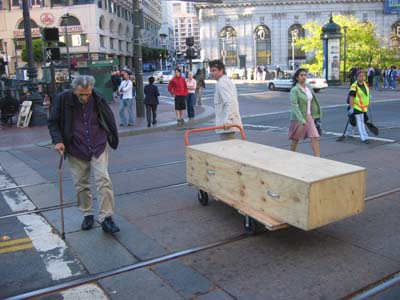
A police car slows down. Officer reviews the situation.
(Sorry, no pic. Camera failure. Blame Canon.)
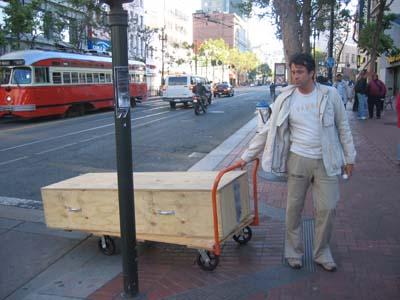
Unscrewing.
Coffin cam check.
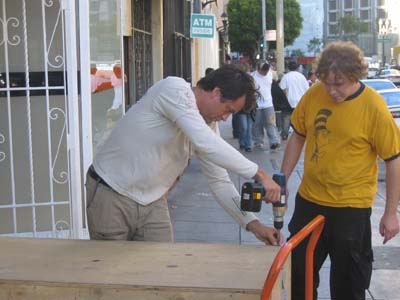
Damn! Power supply box is missing.
We have to buy a new one.
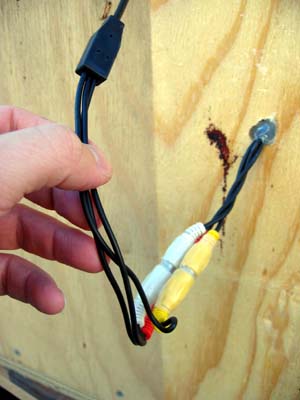
8 PM:
Wireless Flash News publish article:
Austrian Artists Offer A Date With Death
Friday, July 8, 2005
SAN FRANCISCO (Wireless Flash) -- What are you dying to do for fun?
We offer no fun guarantee, besides.
10 PM:
We go to the airport to pick up Anika and Daniel.
[posted by johannes at
7:47 PM]
Tight Schedule
July 6. Afternoon.
Boing Boing and several other blogs report on 'Experience The Experience Of Being Buried Alive'.
Johannes and Günther arrive in San Francisco.
The team receives first interview requests via email.
Meeting at RxGallery with Will and Monika.
The space is awesome.
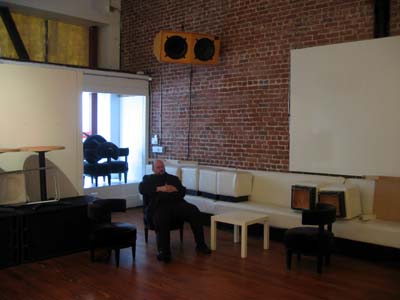
Will and Monika inform us about the current dumpster/dirt status. A couple of problems wait to be solved.
Is that what a contemporary graveyard looks like? Well... yes!
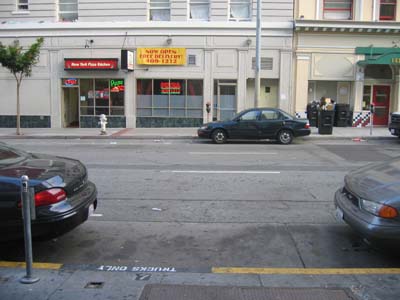
Johannes is glad to hear that the shipment process of the LA coffin went smooth.
We take a walk to a storage room on Jessie Street where the coffin is warehoused.
Günther verifies the coffin's post-delivery condition: "Roger!"
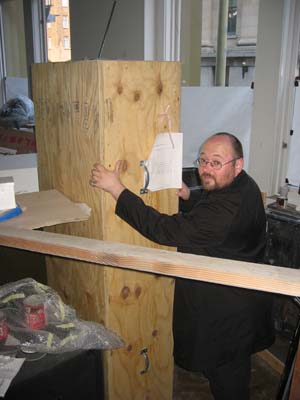
But we have to find an easy way to transport the heavy box to the gallery tomorrow.
[posted by johannes at
11:42 PM]
Request
July 5. Evening.
We just got a nice request.
[...] I was wondering if I could sign up in advance to be buried alive in SF on Friday. I have been daydreaming about being buried alive for the last 6 months or so and one of the projects I have brewing inside of y head is to take pictures of myself with a lover, inside a coffin in my kitchen. Of course, that takes a lot of time to prepare, so I haven't done it yet, but it is one of my favorite ideas. [...]
Normally we don't accept reservations in advance. But I think we'll make an exception this time...
[posted by johannes at
12:06 AM]
SAN FRANCISCO: Experience The Experience Of Being Buried Alive
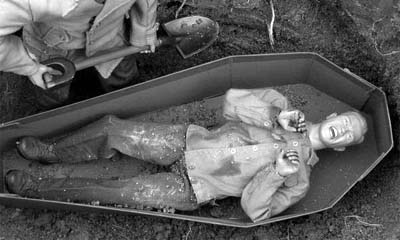
[posted by johannes at
10:43 AM]
Talk / 2nd Attempt
July 2. Afternoon.
2 PM: Evelyn is on her way to the airport to go back to Vienna.
4 PM: Public talk at Contemporary Art Gallery.
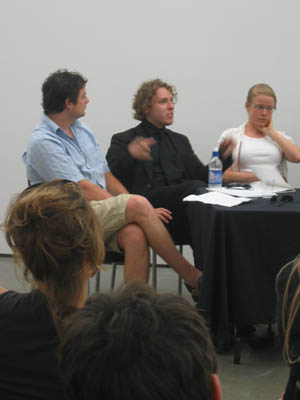
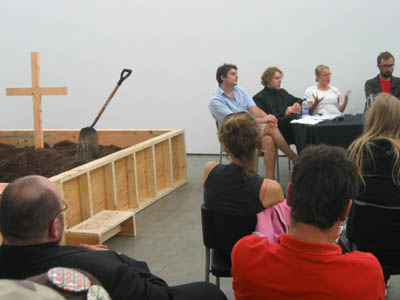
5 PM: Additional burials planned... but all volunteers withdraw. Too bad.
[posted by johannes at
8:59 PM]
Vancouver Auto-Funeral Experience
June 30. Evening.
5 PM: Burial site cam is working fine. No visitors yet. No reservations yet.
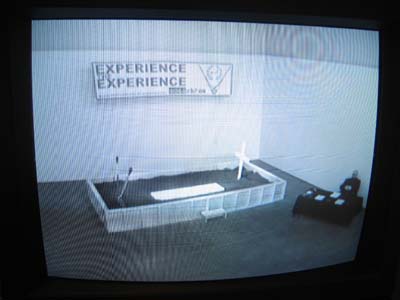
6 PM: First volunteers show up. They sign the damage waiver and get in line.
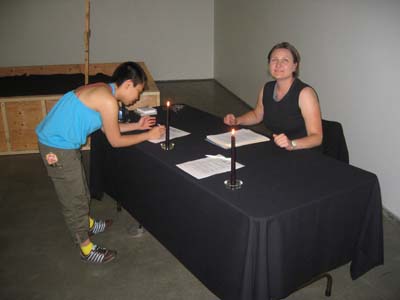
Canadians don't seem to be suspicious at all. Most of the people just sign the waiver without even reading it.
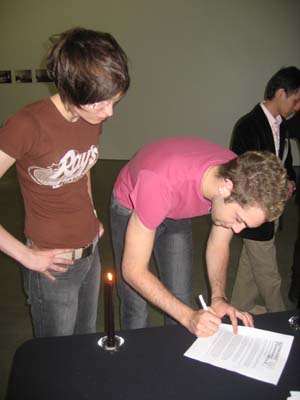
Evelyn is the death jockey of the evening. She informs the guests about the cultural and scientific history of premature burial, administers most of the paperwork, issues the certificates and answers questions such as
- "What is this all about?"
- "How much oxygen is in a coffin?"
- "What happens if somebody panics in there?"
- "Did you ship the soil from Austria?"
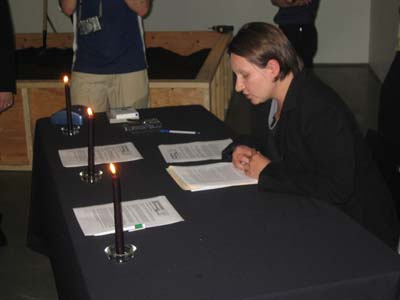
Johannes and Güther have other tasks to fulfill.
- Screwing
- Lifting
- Assisting
- Digging
- Waiting
- Undigging
- Lifting
- Unscrewing
And above all, sweating.
They consume two cans of Red Bull. Suddenly the West Canada Region Coordinator of Red Bull turns up and takes pictures.
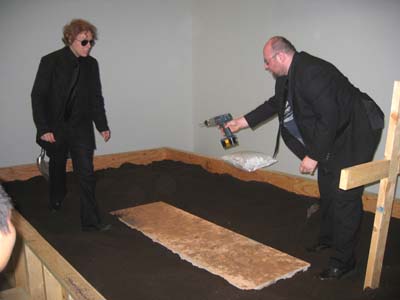
Talk softly and carry a big shovel.
After each exhumation, Johannes takes a polaroid picture of the contestant.
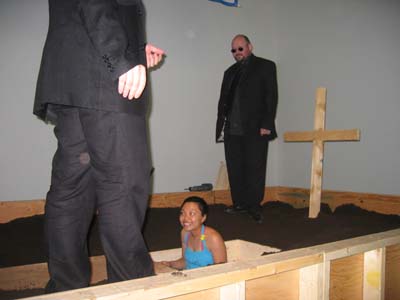
"Next one, please."
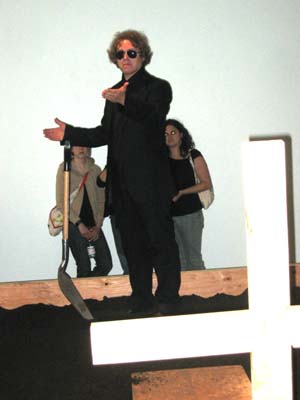
The customers seem to be fully satisfied.
No complaints so far. (But there's no guarantee, whatsoever.)
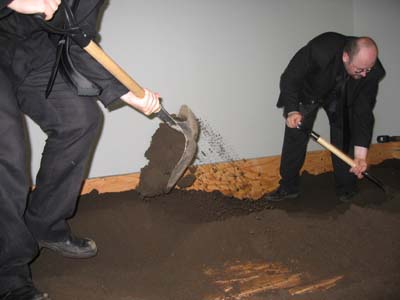
8 PM: Johannes and Günther have to speed up. The demand is increasing exponentially.
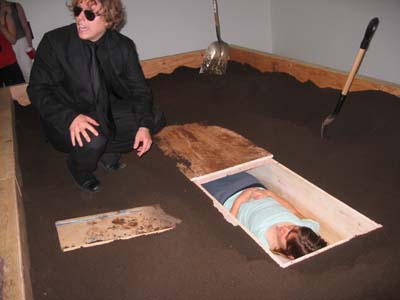
The burial process is getting more and more efficient. The gravedigging unit manages to minimize the in-between-burials time to less than 1 minute and 45 seconds.
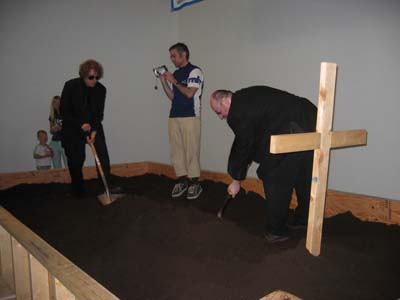
Bright eyes, burying like fire.
(Sorry about the bad wordplay.)
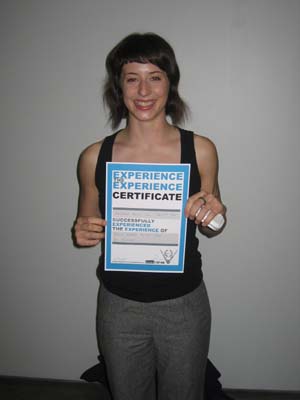
Since the gallery closes at 10 PM we have to put off quite a lot of people.
We decide to provide a couple of more funeral services on Saturday, July 2, 4 PM.
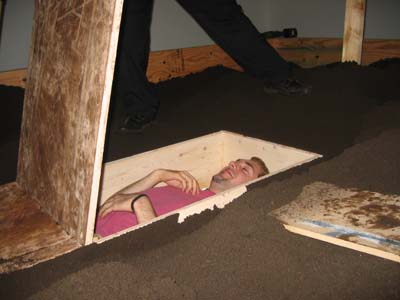
All 17 volunteers on a picture...
(Click to enlarge.)
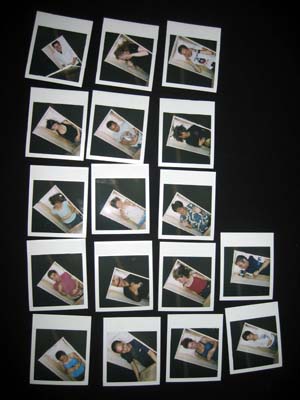
We consume a couple of hundred calories at a bar around the corner.
We return to our hotel.
We sleep the sleep of death.
[posted by johannes at
12:54 AM]
Experience Countdown
June 30. Morning and afternoon.
Günther poses with the brand new Vancouver Auto-Burial Damage Waiver.
You can download it as RTF document.
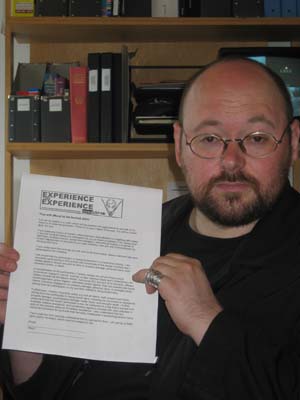
The heavy humid soil deformed the wooden planks over night. We fix the problem.
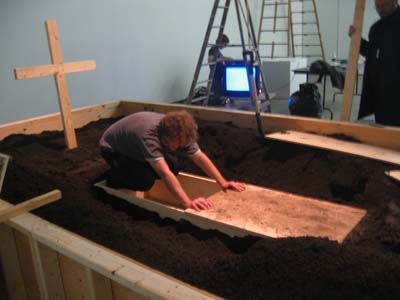
Final vacuuming attempts.
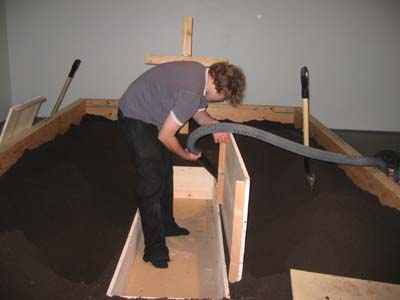
Inside the coffin.
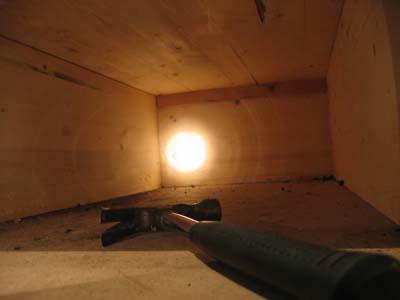
[posted by johannes at
3:08 PM]
Arrangements And Final Handicraft
June 29. Afternoon.
The folks at CAG finish the exhibition captions.

We hang the big tour banner.


We position the gravesite cam for tomorrow's ceremony.

We research about the correct geometrical proportions of a cross (5:4), we do some calculation, get some wood from the gallery's workshop and start building a cross.
It's not as easy as we thought, though...
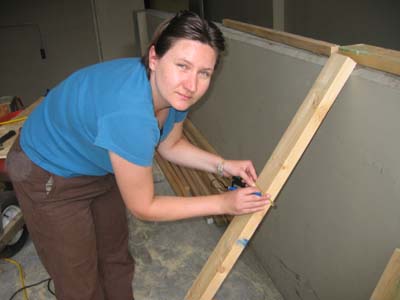
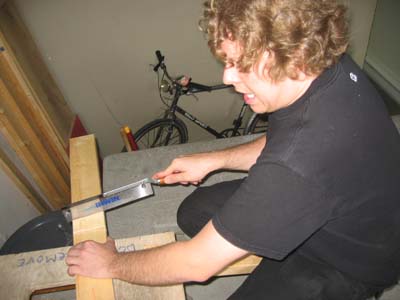
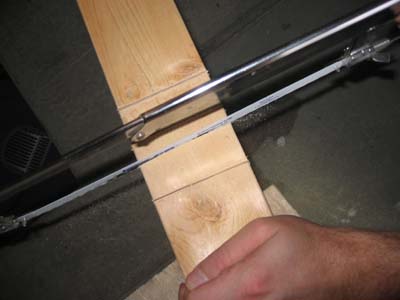
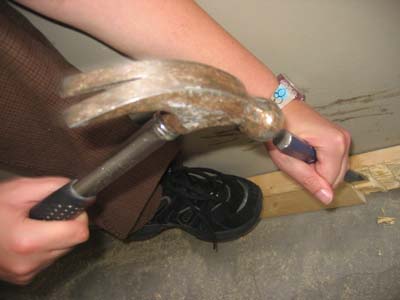
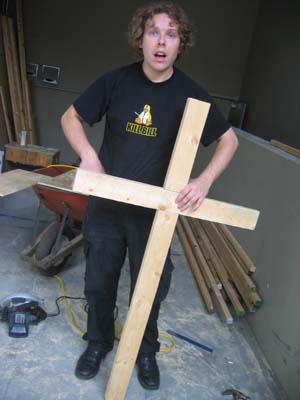 < <
...but we succeed.
DIY Christian Symbolism Deluxe.
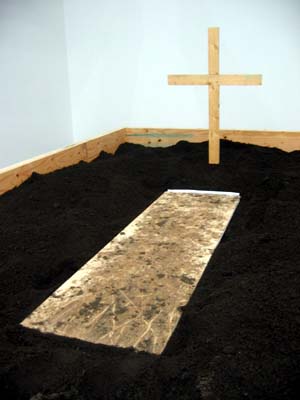
[posted by johannes at
6:27 PM]
Arrival, Earth Moving
June 28. Afternoon.
We arrive in Vancouver.
The people at Contemporary Art Gallery have already built a huge sandbox inside the gallery.
Tom Crean, who is working for a funeral home in Vancouver, donated a pine-box coffin. It's already being placed inside the sandbox.
Compared to the standard sized US coffin we built in Los Angeles this coffin is rather small: approximately 76 inches in length, 23 inches in width and 12 inches in depth.
We wait some time for the dirt to be deliverd. Finally, the truck arrives. It turns out that it's no dirt but beautiful black, sterilized soil. Welcome to Canada.
A couple of really friendly people help us with the earth moving process.
Matthew Hills, wheelbarrow expert.
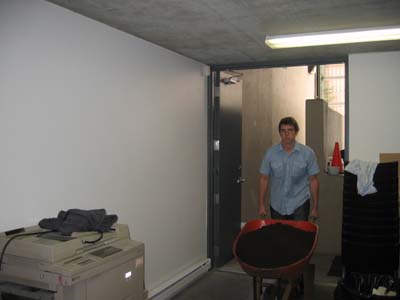
Mareike Nap, power shovel. Assisted by Johannes.
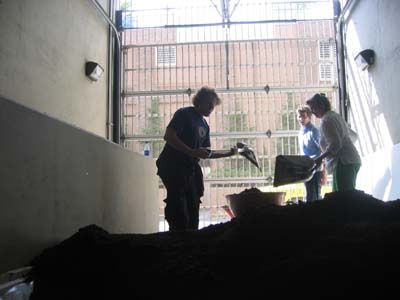
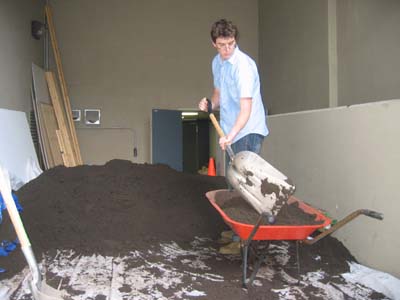
Stephanie Kellington, soil structuring department.
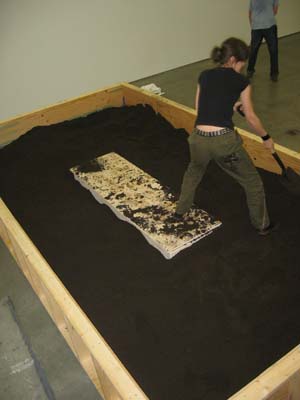
Jennifer Papararo, dirt decreasement coordination.
Andrew Dadson, second wheelbarrow unit.
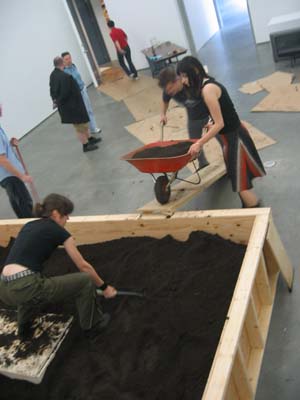
Grant Wong, tilting team leader.
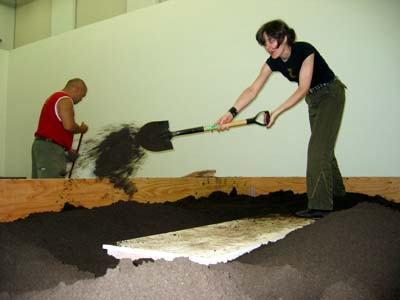
Premature burial soil flattening specialist Sharon Bradley is chosen as our test burial victim.
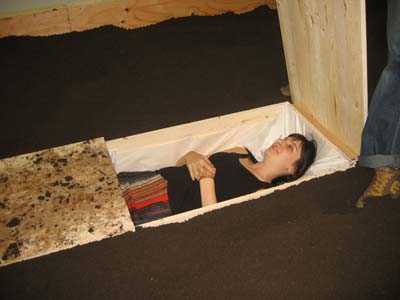
Contemporary Art (Gallery) is dirty. We clean it.
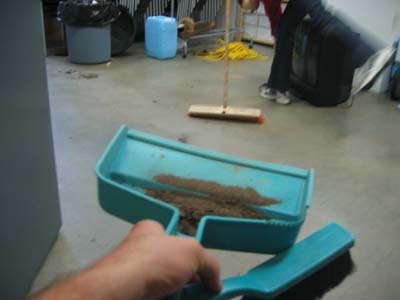
[posted by johannes at
10:44 PM]
VANCOUVER: Experience The Experience Of Being Buried Alive
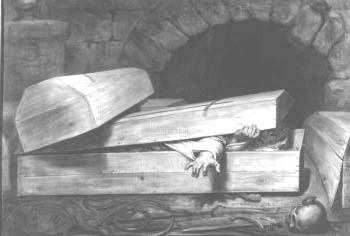
[posted by johannes at
8:40 AM]
Coffin to SF
June 23. Afternoon.
Cookes Crating Inc. pick up the coffin for transporation to RxGallery, SF.
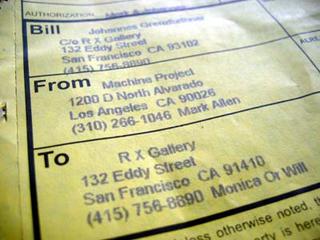
June 23. Evening.
We meet Will Linn of RxGallery, SF. We have a great time. We discuss some details of the upcoming premature burial process in San Francisco.
[posted by johannes at
11:42 AM]
Coffin Recovery
April 22. Afternoon.
Günther, Mark, Johannes and Jason exhume the coffin.
Not an easy task, indeed...
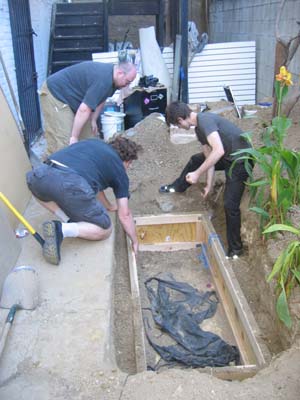
...but they bring home the bacon.
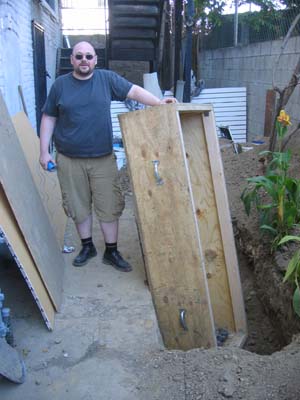
Filling hole.
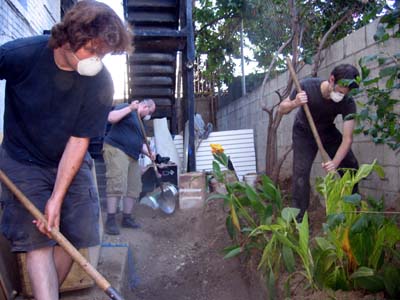
Hole filled.
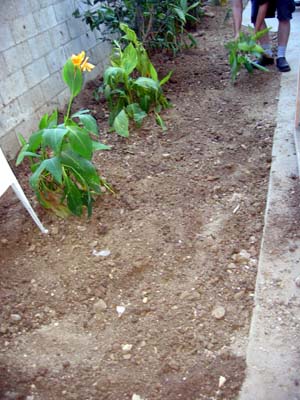
Cleaning coffin.
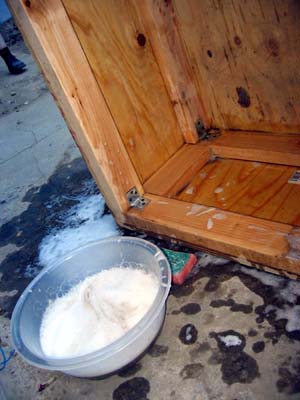
Why would anybody clean a coffin?
We want to ship it to RxGallery/San Francisco for reusal on July 8.
But why not ship it to Contemporary Art Gallery/Vancouver for the auto-burial ceremony on June 30?
Because Tom Crean, who works for a funeral home in Vancouver, is donating a pine-box coffin. Looking forward to meeting Mr. Crean in person.
BTW: The nice radio guy (who interviewed us on June 14) sends us an email. NPR will air the report about 'Experience The Experience Of Being Buried Alive' nationwide on Saturday, June 24. He asks for our complete names. We reply and add some pronounciation advice.Johannes Grenzfurthner (Johannes Graines-foort-na)
Evelyn Fürlinger (Evelyn Fur-linga)
Guenther Friesinger (Goonta Freeze-inga)
[posted by johannes at
5:33 PM]
Downtown LA Report
June 20.
Downtown LA reports about "Experience The Experience Of Being Buried Alive".
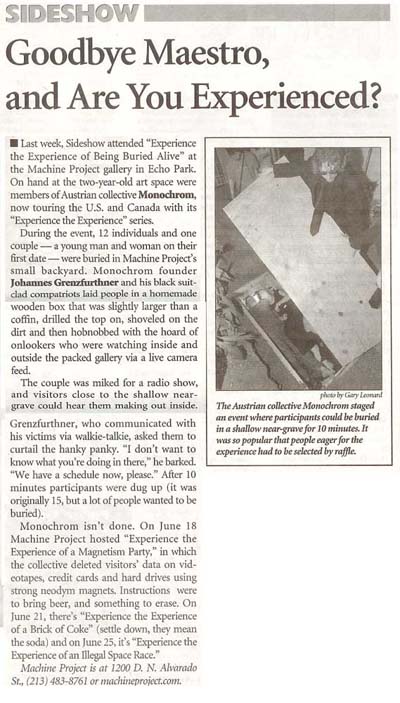
(Click to enlarge)
[posted by johannes at
6:37 PM]
Post-burial feelings
June 15. Day after.
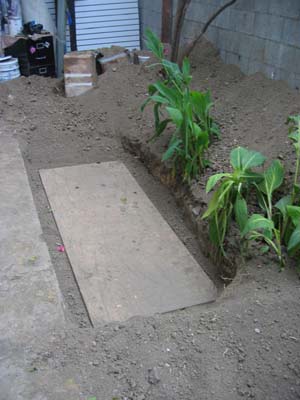
[posted by johannes at
11:50 PM]
LA Auto-Funeral Experience
July 14. Afternoon.
Decoration.
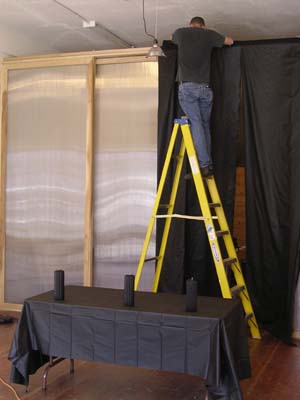
July 14. Evening.
Press arrives.
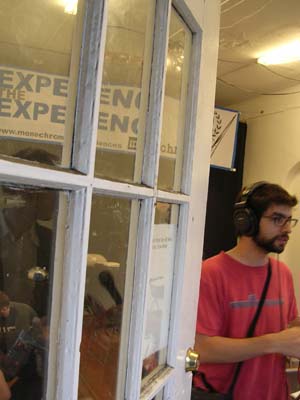
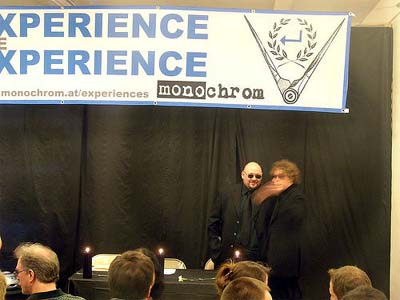
Lecture.
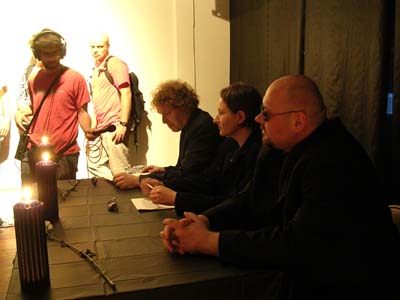
The crowd.
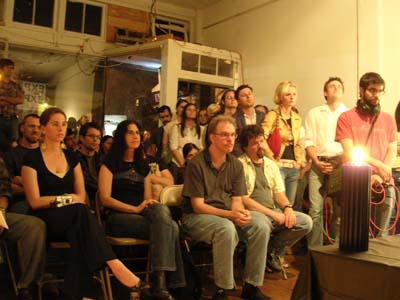
Burying process.
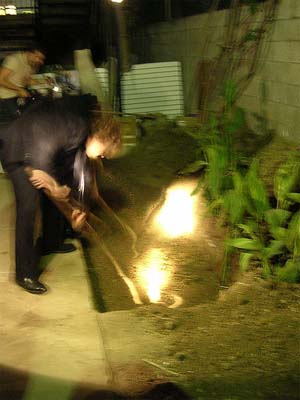
Coffin cam display in front of the gallery.
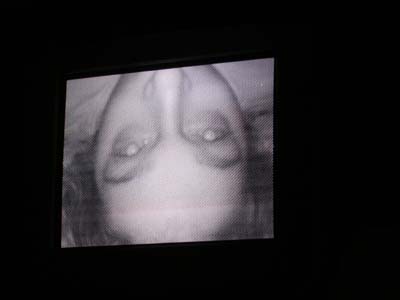
Only people who want to get buried are allowed to visit the gravesite.
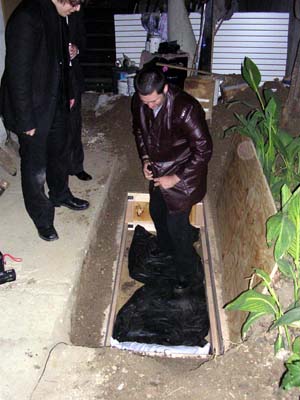
Coffin cam watchers.
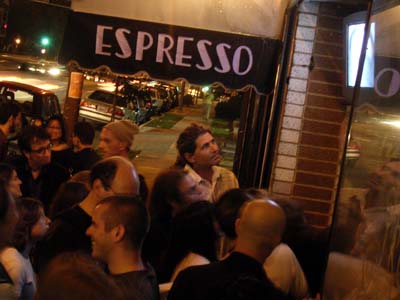
Gravesite cam.
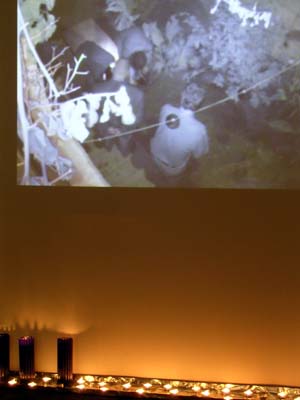
A couple wants to be buried on their first date.
We agree.
(Photo by Gary Leonard.)
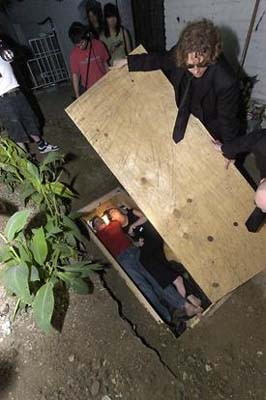
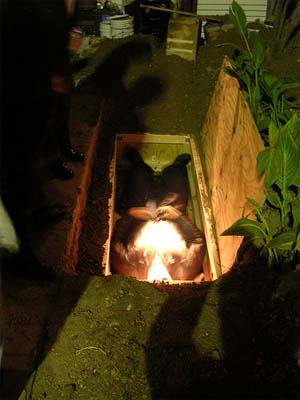
Volunteers who want to help digging but don't want to get buried get permission to join the monochrom gravediggers.
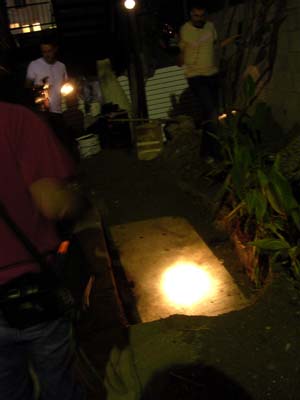
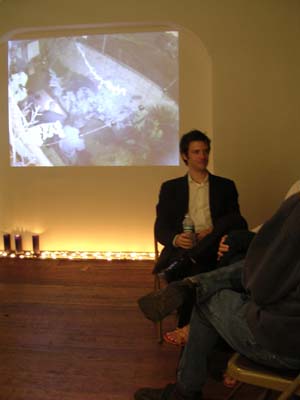
June 15. 1 AM.
12 completed burials.
(Pictures by Zota via Flickr.)
[posted by johannes at
10:36 PM]
Music selection
June 14. Afternoon.
We pick a couple of funeral marches and songs of death for the evening.
Leichenzug mit Blaskapelle
(Funeral March with Brass Band)This is how funerals sound all over middle Europe. Bells are ringing, the priest, the brass band and people who are shambling slowly behind the coffin. And, of course, altar boys. Once upon a time, in a village – the name of which is irrelevant – a tipsy priest fell into the hole. The funeral attendants' sobs immediately turned into shrieks while both grave diggers had considerable trouble getting the infamous clergyman out again. Central Band of the RAF: Marche Funebre
(Chopin's Funeral March)Emotion coming out of the cold! Representing all official state obsequies and other pomp funerals. Chopin's smash hit of death. In this military brass band version it does not lack a certain catatonic iciness. George Lewis, Eureka Brass Band: Just a Closer Walk with TheeVery traditional funeral song of unknown origin.
I am weak, but Thou art strong;
Jesus, keep me from all wrong;
I'll be satisfied as long
As I walk, let me walk close to Thee. Edith und Karl Dworak (Die Pepi Wichart Schrammeln): Stellts meine Ross in Stall (Bring my horses into the stable)It is a kitschy cliche that Vienna is a morbid place. But sometimes it is simply true. This sentimental and bittersweet tearjerker is a Viennese Schrammel-style song of death. Schrammelmusik is usually listened to at the typical Viennese wine taverns -- the Heurigen. The song is about a Fiaker -- a horse carriage driver -- who says:
Bring my horses into the stable
For today they will get a bag of oats and some hay for the last time.
Put a lock at the door for you're getting rid of me today.
Because I no longer am a wagoner, for today I'll peg out. Lou Reed: Goodbye Mass (In a Chapel Bodily Termination)This one is for you Americans. Lou Reed's requiem for his friend Doc Pomus. Serbische Totenklage
Serbian KeenThe Serbian death customs are rooted in the pre-Christian belief in a kingdom-come which can only be reached by crossing a river. Other than the river Styx in classical mythology, this river cannot be crossed on a boat, but only on a tree trunk that is used like a bridge. If the dead person has committed too many sins, then he risks falling into the water. Through the water, he reaches the world underneath, the hells, where it is very dark and very dry. To alleviate this possible post mortal dryness, the women still carry full beer mugs to the graveyards in this area. What a nice custom. Tom Waits: Anywhere I Lay My HeadOh yeah.
(Thanks, Fritz Ostermayer!)
[posted by johannes at
4:56 PM]
Gravesite completed
June 14. Afternoon.
Lots of tasks are still unfinished... but the gravesite is ready.
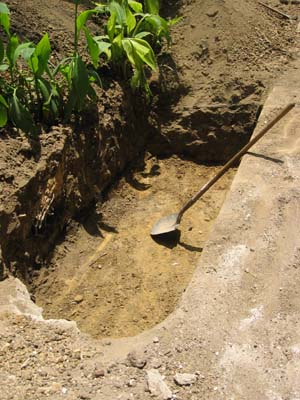
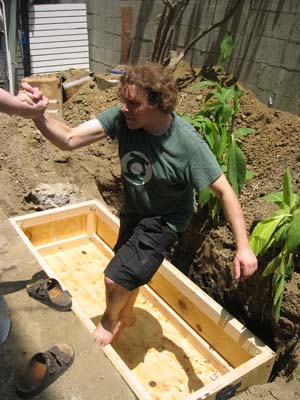
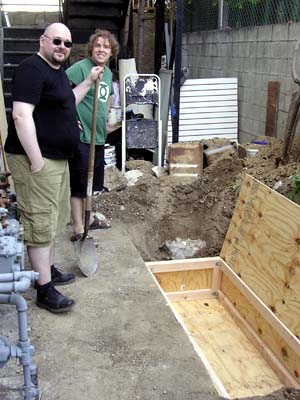
[posted by johannes at
3:16 PM]
Liability waiver
June 14. Midday.
Just in time the liability waiver arrives.
Tremendous thanks to Jason Brown!
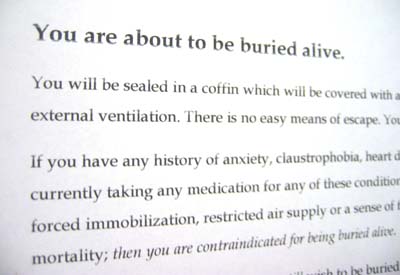
You are about to be buried alive.
You will be sealed in a coffin which will be covered with approximately two feet of dirt. There is no external ventilation. There is no easy means of escape. You will be buried alive, for real.
If you have any history of anxiety, claustrophobia, heart disease or breathing difficulties; if you are currently taking any medication for any of these conditions; if you dislike total darkness, confined spaces, forced immobilization, restricted air supply or a sense of forced helplessness in the face of your own mortality; then you are contraindicated for being buried alive.
If you understand this and yet you still wish to be buried alive, please read and sign your agreement to the following:
I am aware that my participation in being buried alive is a hazardous activity. I am voluntarily participating in this activity with knowledge of the danger involved and I hereby agree to accept any and all risks of property damage, personal injury, post-traumatic stress, or death.
In consideration of my participation, I hereby release Machine Project -- an organization with members whose principal meeting place is located at 1200 D North Alvarado, Los Angeles -- and any of its directors, officers, event organizers, grave diggers, volunteers and/or agents, from any present and future claims, including negligence, for property damage, personal injury, or wrongful death, arising from my participation in any activities related to being buried alive.
Furthermore, I hereby voluntarily waive any and all claims, both present and future, arising from my participation in being buried alive, including but not limited to negligence, property damage, psychological damage, bodily injury, and wrongful death. I further understand that the burial I participate in may be conducted at a site that is remote from available medical assistance; and nonetheless agree to proceed with such activities in spite of the possible absence of medical assistance. I also understand that any equipment provided for my burial may be totally inadequate in preventing serious injury.
I have read this form and fully understand that by signing this form, I am giving up legal rights and/or remedies, which may be available to me.
[Print]
______________________________________
[Sign]
______________________________________
[posted by johannes at
2:02 PM]
And it's free.

[posted by johannes at
12:52 PM]
Coffin tech
June 14. Morning.
We are mounting a night vision premature burial detection cam into the coffin.

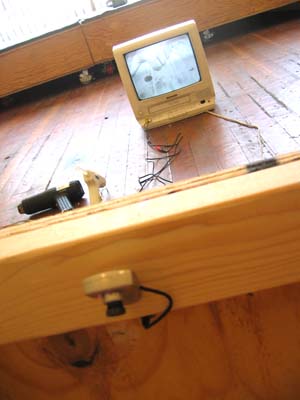
[posted by johannes at
12:49 PM]
Nightshift
June 13/14.
Mark and Dave are taking care of coffin business.
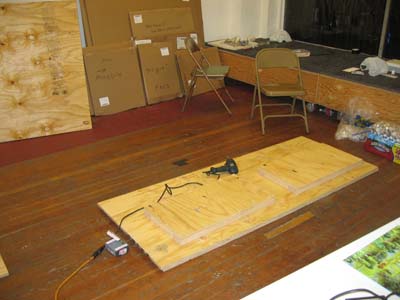
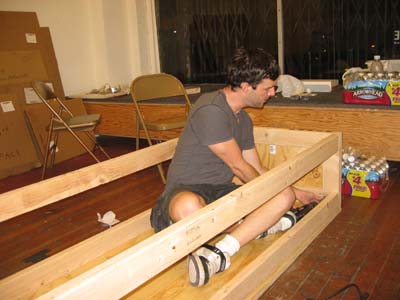
[posted by johannes at
10:20 AM]
First preparations
June 13. Daytime.
Evelyn, Dave and Mark draw some sketches...

... and move on to buy a load of wood.
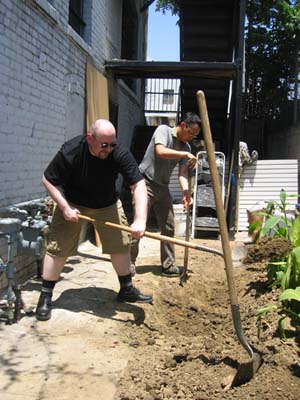
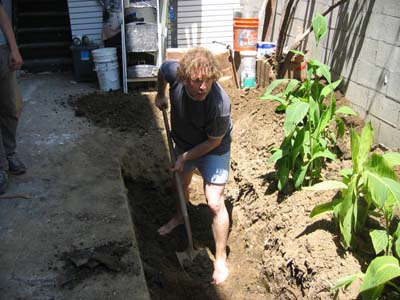
Günther, Jeff and Johannes start to dig a hole in the backyard.
Evening:

Mark, Evelyn and Charly (Machine Project's intern) try to get rid of a chunk of concrete blocking the hole.
[posted by johannes at
3:09 PM]
Being Buried Alive
A very short cultural history.
The fear of being buried alive is one of our most primal fears. The mere thought gives us the creeps and makes our heart beat faster. We find reports about people awaking on their alleged deathbed even in classical antiquity. There's more than one text testifying that some poor fellow came back to life right on their cremation table and could not be spared the gruesome fate of being burnt alive.
With the introduction of coffins the fear of regaining consciousness six feet under became a considerable factor, developing into a serious case of mass hysteria in Germany and France in the 18th and 19th century.
People awaking from death are a powerful literary motif. Stories about apparently dead people in post-medieval Europe are galore. One of the most gruesome stories is that of a young Swedish girl who supposedly died in a state of advanced pregnancy. In the evening after she was buried, the verger hears pitiful groans from the courtyard. Highly superstitious and afraid of ghosts, he runs home and hides under his bed sheets. When he tells the rector about his observation the following morning, the clergyman orders the coffin to be exhumed, not without reproaching the verger for his superstition. The opening of the coffin produced a terrible sight: the girl had given birth in her coffin and died in her own blood.
This is just one of many hundreds of ghastly tales in the same vein. In the 18th and 19th century these collections -- like the Thesaurus of Horror, published in 1817 -- attracted thousands of readers and lead to a sudden upsurge in fear of apparent death and premature burial in the 1740s, and for more than 200 years to come, a scientific debate was to keep Europeans of all social backgrounds busy: the controversy over the fallibility of the signs of death.
In classical antiquity the absence of a heartbeat was the accepted sign of death. Yet, there is also evidence that there might have been an awareness of the fallibility of this criterion. The Greek physician Galen already recommended great caution in declaring people dead in case of certain diseases like hysteria, asphyxia, coma, catalepsy, and with people who have died from excessive grief or joy, or from intoxication with alcohol or soporific drafts.
But the scientific achievements of antiquity were lost in medieval Europe, and the Europeans had to start from scratch. At that time, the average European was never in all his or her life seen by a medical practitioner. It was therefore very common that people were declared dead by educated laypersons. For these laypersons, the absence of respiration and of bodily reflexes was enough to signify death. The idea of death being a transition, a gradual process, did not exist. Thus, a person who did not breathe was dead, and if they came back to life, they were ghosts. Period.
In the 17th century death was still something completely supernatural and inexplicable – the miracle of death. Lots of legends and anecdotes told stories of bleeding corpses, speaking skulls and cadavers growing hair. These incidences were regarded as bad omens, predicting famine and disease, and none of these inspired more careful scrutiny of individuals presumed dead.
The common practice of burying bodies as quickly as possible -- especially in times of epidemic plagues -- poses another problem. The usage of coffins provides allegedly dead people with oxygen for about 60 minutes, enough time for somebody who died of, say catalepsy or who froze to death, to regain consciousness and die a second horrible death. The image of this has inspired some of the most gruesome tales of all time. The reader is spared no detail of this torture underground: you hear tales of people gnawing their fingers (sometimes their whole hands) in agony, people whose bodies were found in unnatural positions, with bundles of their own hair in their clenched fists, their faces distorted with the most horrible of grimaces. An image of despair, a foretaste of hell to the fear-stricken reader.
There is, for example, the story of a French soldier called Francois de Cirille, who is said to have been declared dead three times! He had been born by cesarean section to a dead mother exhumed from her coffin. After becoming an army captain, he was severely wounded in battle and buried alive in a mass grave. His servant, who wanted to dig his master a more fitting grave, discovered that he was not dead. While he was recovering, a troop of hostile soldiers burst into the house and threw him into a dung heap, where he lay buried for three days until rescued for the third time. According to his gravestone in Milan, he finally died at the age of 105. He froze to death while "serenading the lady of his heart all night long".
The most famous story of a premature burial is that of the Lady With the Ring. The story is that of a rich lady who dies and is buried with a very precious ring in the family vault. In the night, thieves break into the vault to steal the ring and the lady regains consciousness. This story exists in different variations all over Europe, in some of which the lady is raped by an obviously necrophiliac grave robber. In others the criminals cut the lady's finger off, and she awakes due to this harsh treatment. Some of the stories tell us that the lady runs through the streets in panic and is killed by frightened inhabitants of the town. Another version has it that her loving husband thanked the thieves for bringing his beloved lady back to life by giving them the ring as a present.
By the end of the 17th century some medical practitioners in Germany developed an awareness for the fallibility of the signs of death and suggested longer waiting periods between the time of alleged death and the burial of the corpse, along with caution in cases of certain conditions, very much like those Galen had in mind.
In 1740 a Danish anatomist, Jacob Winslow, postulated that people are at an immediate risk of being buried alive. He states that (quote) "death is certain, since it is inevitable, but also uncertain, since its diagnose is sometimes fallible."
He argues that the only reliable evidence that a person is dead is the onset of putrefaction and the appearance of livid spots. He suggests that no one be buried until they show signs of putrefaction, and that supposedly dead people be taken care of in warm beds and attempts be made to bring them back to life by tickling them with the quill of a pen or by introducing strong smells to their nostrils. But he also suggests rather brutal methods of resuscitation, like putting urine into the mouth of the poor victim, or cutting them with razors, thrusting pins under their nails, or pouring boiling wax on their foreheads, and even worse proposals that involve the most sensitive parts of the human body. Yet, one has to bear in mind that Winslow was only guided by his humanitarian feelings!
In spite of the startling contents, Winslow's work would have had little impact had it not caught the eye of the French physician and translator Jean-Jacques Bruhier d'Ablaincourt. He was a skilled linguist and a scholar with considerable understanding of European history and culture, and, like Winslow, he was a member of the Academy of Science. Bruhier's translation of Winslow's "The Uncertainty of the Signs of Death" was an immediate success. Bruhier himself emerges as a fully fledged campaigner for burial reform and adds some of his own stories to the volume. He argues, for example, that Jesus could not have raised Lazarus from the dead, if putrefaction had been awaited before the man had been declared dead. Bruhier also presented King Louis XV with his idea that bodies ought to be supervised for 72 hours or until putrefaction set it, before being buried. The King was impressed but postponed the project indefinitely after his ministers had estimated the costs of the reform. Nevertheless, Bruhier's book was immensely popular for years. Bruhier rejected all kinds of superstition, he was a rationalist in the Age of Enlightenment. He only makes one mistake: the book also contains a long list of "case reports", all the stories about apparent death and premature burial Winslow and Bruhier could get hold of, and Bruhier defends every single one of these cases, even the least credible ones.
As mentioned before, the subject was fascinating and stories on the topic abound, but these are not all case reports; most of these stories serve only one purpose: to entertain the public with tales about resuscitation, necrophilia, and with obviously sadistic overtones.
Bruhier therefore had two major groups against him: the Catholic Church because of his atheistic statements, and of course the medical profession (there were quacks and charlatans all over the place), who would not have it that they should not be able to tell a dead man from a live one.
But Bruhier's book was elegantly written and convincingly argued, and therefore accessible for the educated laypersons themselves. Hence the crucial information that the signs of death might be fallible went directly to the population, unfiltered by the authorities of church and science.
The book was translated into English, Swedish and German, and it caused considerable debate on the subject, which led to an upsurge of fear of premature burial in the mid 18th century, and some people even made wills requesting to be decapitated before their burial, in order to make sure they were really dead.
The 1740s were the perfect time for a fear of premature burial to develop. There was still a good deal of superstition around about abnormal fasts, swallows hibernating under water and submarine humans, but the rationalist medical scientists no longer considered these phenomena supernatural and cast doubt on the prevailing signs of death, which were still lack of respiration and pulsation. The scientist Reaumur made the observation in 1740 that an unconscious, breathless and pulseless individual can be brought back into live through artificial respiration, which was a sensation.
Bruhier managed to brush all criticism aside and become accepted by a majority of doctors and educated people. As an anti-premature burial activist he had many followers, and the call for a waiting period of at least 12 hours before corpses were buried became louder. Of course, the argument that dead bodies were a risk for public health in times of epidemic plagues weighed heavily. It was argued that the risk was higher to lose many than the gain of saving a few.
However, the Austrian court physician Gerard van Swieten agreed with Bruhier that putrefaction was the only certain sign of death, and he proposed to the Empress Maria Theresia that it become obligatory throughout Austria for at least 48 hours to pass between death and burial. Many German states followed suit and demanded a delay in burial of between 24 and 48 hours.
Thus, one significant positive effect of Bruhier's work was that it became accepted practice, throughout large parts of Europe, to wait at least 12 to 24 hours before any person was buried. Bruhier's warning that people who died from apoplexy, drowning, freezing to death and "hysteric conditions" were especially prone to be buried alive had the desired effect and probably saved lots of people from a gruesome fate. Humane societies were founded not only in Europe but also in America, and resuscitation on bodies found in lifeless conditions became widely accepted practice.
While England turned a deaf ear on the problem of premature burial that shook the continent, Germany developed a downright hysteria on the topic. All over Germany by the end of the 18th century there were calls for so called Leichenhäuser (waiting mortuaries), a concept conceived by the German Christoph Wilhelm Hufeland, who also wrote about the phenomenon of Scheintod (apparent death or death trance). These buildings were designed to keep bodies under surveillance until putrefaction set in. By 1795 Berlin had three Leichenhäuser, the one in Munich even had a luxury department and it admitted visitors for a small fee. Some of these mortuaries also adopted strange alarm systems, like strings attached to the fingers of the corpses, so that the guide would be informed by an alarm bell should a body come back to life and move, and weird resuscitation devices to bring people back to life.
Literature on the horrors of being buried alive blossomed.
In the 1840s there were riots in Lisbon, where people went out on the street because the huge demand for waiting mortuaries was not met.
90 years later, the waiting mortuaries were still in use, but no longer popular in Germany. They were sinister, unpleasant places, they emanated an overpowering stench and were very expensive. Eventually, they were all closed down.
But another branch of inventions to rescue victims of premature burial emerged. In the 19th century lots of so called security coffins were patented worldwide. Most of them had tubes linking the buried coffin with the world above, some had alarm systems like bell ropes. The simpler versions had safety springs that opened the lid if a mechanism was triggered by the inhabitant. Others were supposed to be linked via strings to the church bell. Some offered the luxury of lamps inside the coffin or even air-conditioning. One model was equipped with a pyrotechnical rocket that could be launched through the security tube of the coffin. Somehow, none of these ideas really caught on.
By that time the extremely defeatist standpoint was overcome that putrefaction is the only reliable sign of death, and medical science made attempts to find reliable alternatives. The invention of the stethoscope was a huge step, but back then, a stethoscope was more or less a wooden hearing trumpet and therefore still unreliable. Some of the more obscure suggestions included the so called thanatometer: a long thermometer supposed to be introduced into the stomach of the person to measure the temperature in the core of the body. A certain Dr. Labode invented an electronic tongue-pulling machine, because he believed that pulling the tongue will always revive an apparently dead person. A French doctor invented a pair of strong pincers with which to pinch the two nipples. A German called Middledorph even suggested a small flag be attached to one side of a needle, which would then be thrust into the heart. If the person was still alive, and the heart still beating, the flag would wave merrily, he thought.
One of the more reasonable ideas came from an Italian named Dr. Monteverdi. He found out that the subcutaneous injection of liquid ammonia produced an inflammatory reaction in a living person but none in a corpse. This method is infallible, but there was the problem that the injection needs to be carried out correctly and syringes were a rather new invention.
In the 1820s and 30s the fear of premature burial in Germany began to wane anyway. But now it gained full strength in France. The French newspapers covered thousands of stories of people coming back from the dead, people rescued from the grave and people found in unnatural positions in their exhumed coffins. The French ignored the fact that in Germany the waiting mortuaries were closed, and that there was not one single case of apparent death reported in all the waiting mortuaries in Germany. The Germans were more and more reluctant to deposit their dead there.
Yet, there was lots of agitation for the erection of such buildings in France.
King Louis Philippe even set up a commission in 1844 to evaluate the truth of the rumors that people were frequently buried alive.
In the 1860s the Dutch professor Alexander von Hasselt was the first to contradict Bruhier and Hufeland by stating that the signs of death were perfectly reliable. He also described the role of the French newspapers in this hysteria, and he began to investigate and demonstrate that these stories were all untrue by simply travelling to the villages and asking the people who supposedly awoke from the dead. Basically all of them were impudently made up.
Still, the medical advances of the late 19th century had added some arguments in favor of the uncertainty of the signs of death. Scientists discovered that cardiac massage could restart a heart that had stopped beating and that anesthesia could produce a death trance resembling apparent death.
By that time the wave of hysteria had crossed the Atlantic, and newspapers in the US featured the same kind of gruesome stories as the French newspapers. But these stories kept nourishing the debate and peoples' suspiciousness of the medical profession which annoyed lots of doctors.
In 1905 the anti-premature burial movement gained new momentum through the appearance of a young Swedish girl, a suffragette, who was driven by a burning hatred of the wrongdoings of the medical profession. Her name was Emilie Louise Lind-af-Hageby, and in her sensationalist agitation during speeches she held in Great Britain, she claimed that tens of thousands of people were buried alive each year. Finally, the premature burial hysteria reached England, and a journal was established, the "Burial Reformer". Emilie was very successful with her one-woman campaign. She was witty, bright and elaborate and more than a match for the priests and newspapers that opposed her. But after some years of premature burial activism, she lost interest in the cause and the movement fell into terminal decline.
It has to be mentioned that the anti-premature burial activists also had a very strong link to organized spiritualism. Its aims throughout the years were basically reactionary, preferring cleanliness and goodness as the way to health against the discoveries of germs, bacteria, and vaccines. Some even opposed medical research and practitioners as a whole, which might easily have caused a medical disaster.
By the way, Hans Christian Andersen, Arthur Schopenhauer and Alfred Nobel lived in fear of premature burial.
So, how high was the risk of being buried alive really?
As mentioned before, on closer examination the gruesome tales of people awaking in their grave and those narrowly escaping the horrible fate of being buried alive basically prove to belong to the realm of folklore, like ghost stories. All the figures are highly exaggerated and there are basically only a few underlying tales that crop up in many variations all across Europe.
But what about the newspaper reports? Most of them follow the same scheme and are obviously made up. But there are also reliable sources telling about bodies found in unnatural positions in exhumes coffins.
Now we know that these things are easily explained by science. We know that the process of putrefaction makes corpses move their hands and feet. After death the body relaxes and the victim seems to smile, then cadaveric rigidity sets in and the gradual contortion of the musculature may produce a hideous grimace. There are tales about shattered coffins. Even these can be the result of perfectly normal processes. Sometimes corpses explode because they produce a huge amount of putrefaction gases. There are reports of gnawed fingers or hands. These are most certainly caused by rodents feeding on the dead bodies; they always start at the fingertips, working their way up the arms to the torso.
But how can the cry for help be explained that is very often part of these reports? Well, the putrefaction gases seek a way out and sometimes they simply pass the larynx, causing a sometimes quite loud moaning sound. Scientists call it the 'Totenlaut'. This sound must also have been what the superstitious verger heard in the story about the girl giving birth in her coffin. And the building up of putrefaction results in highly increased intra-abdominal pressure. It can be strong enough to expel an unborn child from the womb.
Well, we have one phenomenon left, which is also part of some of the reliable case reports: the detail that sometimes the clenched fists of the corpses are full of hair pulled out at the roots and matching that on the corpse's head. And there is no natural explanation for this!
So there obviously were victims of premature burial, but the figures the burial reformers presented to the public were surely highly exaggerated. It also has to be said that in all the German waiting mortuaries over all these decades, not one single case of apparent death has been recorded!
Well, the question remaining is: does it still happen today?
One of the most famous cases of all times is that of the Frenchman Angelo Hays, who had a motorcycle accident in 1937. His head had hit a wall, and he was declared dead and was promptly buried. Since his father had a life insurance of 200.000 Francs on the boy's life, an insurance inspector had the coffin exhumed to ascertain the cause of death. Two days after the burial he found the body still warm! The young man had been deeply unconscious, which lead to a diminished need for oxygen, and the earth with which the coffin was covered was very dry and therefore permeable.
After several operations he completely recovered and became a downright celebrity. He toured through Europe presenting a security coffin he had invented after his "rebirth". It contained library books, food supplies, had air conditioning, a radio, a chemical toilet, an oven and a refrigerator. It cost about as much as an automobile at the time.
But today high caution is taken in cases such as head trauma, drowning, lightning, electrocution, hypothermia, drug poisoning or intoxication with narcotic substances, and with people who freeze to death.
One remaining problem is that of suicide attempts with barbiturates in the cold. Lower body temperatures decrease the need for oxygen and barbiturates prevent shivering. There may be just 10 heartbeats per minutes or less and just 2 or three respirations. In this case people may be falsely declared dead by inexperienced practitioners.
So nowadays, with brain death widely accepted as a reliable sign of death (people who are brain dead always die within two weeks without regaining consciousness), there is theoretically only one thing you will have to bear in mind if you want to prevent premature burial:
Simply avoid taking a drug overdose when outside in cold weather!
[posted by johannes at
9:26 AM]
Problems?
Mark Allen (Machine Project) has to deal with some problems...
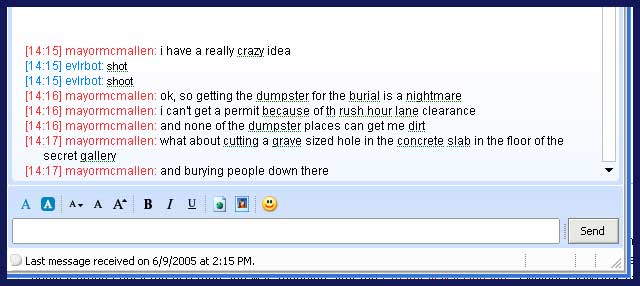
[posted by johannes at
1:08 PM]
LOS ANGELES: Experience The Experience Of Being Buried Alive
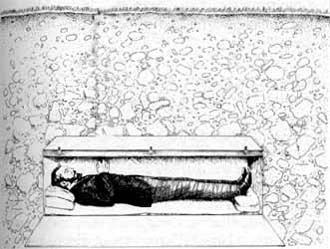
[posted by johannes at
10:51 AM]
|